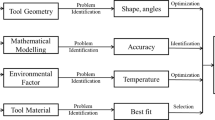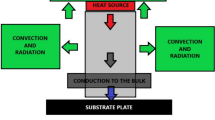Abstract
Submerged arc welding (SAW) is a fusion joining process, known for its high deposition capabilities. This process is useful in joining thick section components used in various industries. Besides joining, SAW can also be used for surfacing applications. Heat Affected Zone (HAZ) produced within the base metal as a result of tremendous heat of arc is of big concern as it affects the performance of welded/surfaced structure in service due to metallurgical changes in the affected region. This work was carried out to investigate the effect of polarity and other SAW parameters on HAZ size and dilution and to establish their correlations. Influence of heat input on dilution and heat affected zone was then carried out. Four levels of heat input were used to study their effect on % dilution and HAZ area at both the electrode positive and electrode negative polarities. Proper management of heat input in welding is important, because power sources can be used more efficiently if one knows how the same heat input can be applied to get the better results. Empirical models have been developed using statistical technique.
















Similar content being viewed by others
References
Adler Y P 1975 The design of experiments to find optimal conditions. Moscow: Mir Publishers
Anderson V L and McLean R A 1974 Design of experiments-a realistic approach. New York: Marcel Dekker, Inc
ASM 1993 Welding, Brazing and soldering, vol 6. ASM Handbook. USA: ASM International
Chandel R S 1987 Mathematical modeling of melting rates for submerged arc welding. Welding Journal, Welding Research Supplements:135s–140s
Chandel R S, Seow H P and Cheong F L 1997 Effect of increasing deposition rate on the bead geometry of submerged arc welds. J. Materials Processing Technol. 72(1):124–128
Clark J N 1985 Manual metal arc weld modelling. Part 1. Effect of process parameters on dimensions of weld bead and heat-affected zone. Mater. Sci. Technol. 1:1069–1079
Dhas J E R and Kumanan S 2011 Optimization of parameters of submerged arc weld using non conventional techniques. Appl. Soft Comput. 11(8): 5198–5204
Easterling K E 1992 Introduction to the physical metallurgy of welding. 2nd edn. Oxford: Butterworth-Heinemann Ltd
Fnides B, Yallese M A, Mabrouki T and Rigal J F 2011 Application of response surface methodology for determining cutting force model in turning hardened AISI H11 hot work tool steel. Sadhana 36(1): 109–123
Ghosh A, Chattopadhyaya S, Das R K and Sarkar P K 2011a Assessment of heat affected zone of submerged arc welding process through digital image processing. Procedia Engineering 10: 2782–2785
Ghosh A, Chattopadhyaya S, Das R K and Sarkar P K 2011b Prediction of submerged arc welding yield parameters through graphical technique. Procedia Engineering 10: 2797–2802
Ghosh A, Chattopadhyaya S and Sarkar P K 2011c Critical analysis of confounded parameters of SAW process. Procedia Engineering 10: 2786–2790
Gunaraj V and Murugan N 1999a Prediction and comparison of the area of the heat-affected zone for the bead-on-plate and bead-on-joint in submerged arc welding of pipes. J. Materials Processing Technol. 95(1–3): 246–261
Gunaraj V and Murugan N 1999b Application of response surface methodology for predicting weld bead quality in submerged arc welding of pipes. J. Materials Processing Technol. 88(1–3): 266–275
Karaoğlu S and Seçgin A 2008 Sensitivity analysis of submerged arc welding process parameters. J. Materials Processing Technol. 202(1–3): 500–507
Khallaf M E, Ibrahim M A, El-Mahallawy N A and Taha M A 1997 On crack susceptibility in the submerged arc welding of medium-carbon steel plates. J. Materials Processing Technol. 68(1): 43–49
Kou S 2003 Welding metallurgy. 2nd edn. USA: John Wiley & Sons, Inc
Lancaster J F 1993 Metallurgy of welding. 5th edn. London: Chapman & Hall
Mason R L, Gunst R F and Hess J L 2003 Statistical design and analysis of experiments Wiley Series in probability and statistics, 2nd edn. New Jersey: John Wiley & Sons, Inc
Montgomery D C 2001 Design and analysis of experiments. 5th edn. Singapore: John Wiley & sons Inc
Murugan N and Gunaraj V 2005 Prediction and control of weld bead geometry and shape relationships in submerged arc welding of pipes. J. Materials Processing Technol. 168(3): 478–487
Murugan N and Parmar R S 1993 Effect of submerged arc process variables on dilution and bead geometry in single wire surfacing. J. Materials Processing Technol. 37: 767–780
Om H and Pandey S 2010 Effect of electrode polarity in submerged arc welding process. Paper presented at the Twenty fourth Indian Engineering Congress, NIT Surathkal, Mangalore, India, December, 10–13
Pandey N D, Bharti A and Gupta S R 1994 Effect of submerged arc welding parameters and fluxes on element transfer behaviour and weld-metal chemistry. J. Materials Processing Technol. 40(1–2): 195–211
Pandey S 2004 Welding current and melting rate in submerged arc welding: A new approach. Australasian Welding Journal Supplements 49(Second Quarter): 33–42
Shen S, Oguocha I N A and Yannacopoulos S 2012 Effect of heat input on weld bead geometry of submerged arc welded ASTM A709 Grade 50 steel joints. J. Materials Processing Technol. 212(1): 286–294
Tušek J 2000 Mathematical modeling of melting rate in twin-wire welding. J. Materials Processing Technol. 100(1–3): 250–256
Wen S W, Hilton P and Farrugia D C J 2001 Finite element modelling of a submerged arc welding process. J. Materials Processing Technol. 119(1–3): 203–209
Yang L J, Chandel R S and Bibby M J 1992 The effects of process variables on the bead width of submerged-arc weld deposits. J. Materials Processing Technol. 29(1–3): 133–144
Yang L J, Chandel R S and Bibby M J 1993 The effects of process variables on the weld deposit area of submerged arc welds. Welding Journal Welding Research Supplements: 11s–18s
Author information
Authors and Affiliations
Corresponding author
Rights and permissions
About this article
Cite this article
OM, H., PANDEY, S. Effect of heat input on dilution and heat affected zone in submerged arc welding process. Sadhana 38, 1369–1391 (2013). https://doi.org/10.1007/s12046-013-0182-9
Received:
Revised:
Accepted:
Published:
Issue Date:
DOI: https://doi.org/10.1007/s12046-013-0182-9




